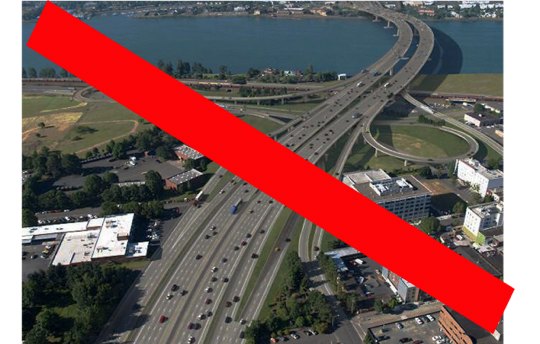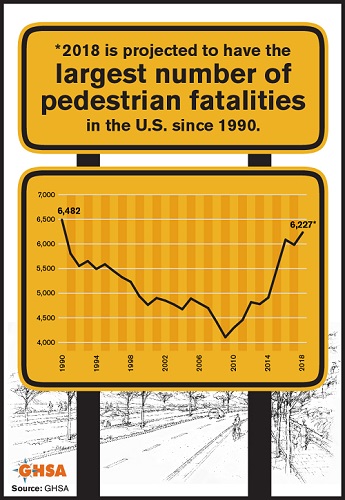Too often, progressive transportation advocates have been rolled by the highway crowd; No more, says Transportation for America
Three principles for reform: Fix it First, Safety before Speed, Accessibility, not Mobility.
There’s been a kind of Kabuki theatre around federal transportation funding legislation over the past two decades. Advocates for transit, biking and walking form a loose coalition with the traditional highway interests to browbeat the Congress in to putting more money into transportation. Every few years, we get an omnibus piece of legislation with an inscrutable acronym (SAFTEA-LU and MAP-21), and a few more odd billion dollars. And for the past 25 years, all of the increased funding has been on the back of taxpayers, it’s been regarded as politically impossible to raise the so-called “user fees”–in the form of the federal gasoline tax. The result has been more than $100 billion used to subsidize transportation, chiefly car transportation.
While they’ve been reliable allies to the highway lobby, progressive transportation forces have essentially gotten crumbs. In the face of growing evidence of climate change and a strong demand for urban living, all of the key indicators of transportation system performance are telling us the current approach is failing. Vehicle miles traveled and carbon emissions are rising. More pedestrians are being killed in the US. Transit ridership is falling.
Given our social and environmental challenges, and the great opportunity to meet an unrequited demand for car-free and car-lite urban living, we need a different approach to national transportation policy.
Finally, Transportation for America has said “Enough.” It has announced that it won’t support more federal funding for transportation until there’s been some fundamental reform of the policy that guides the the use of these funds.
New principles for federal transportation policy
Transportation for American has laid out three key principles that they say should govern federal policy:
Fix it first. The case more more transportation spending is always pitched as the need to patch potholes and repair bridges, but state highway departments routinely use added funding not to address these backlogs, but instead increase highway capacity. Advocates have seen this kind of bait and switch often-enough to know that without requiring maintenance to be prioritized, additional money just means more lanes of traffic, and thanks to induced demand, even more congestion. (As we’ve pointed out at City Observatory, to many highway engineers, induced demand is more of a feature than a bug–it just continually generates a “need” for ever more road construction. Transportation for America wants a real priority for maintenance.
Safety before speed. Transportation for America highlights recent findings from the National Transportation Safety Board (NTSB) confirming what we’ve long known: excessive speed is in principal cause of roadway crashes and fatalities. Despite the lip service many state’s play to safety–routinely blaming vulnerable road users and trying to achieve safety largely with gimmicky ad-campaigns, the real priority of most transportation programs is “making cars go faster.” Criteria like level-of-service and the 85th percentile rule for setting speed limits are so deeply imbedded in the thought processes and design standards of the transportation system that its impossible to challenge. Transportation for America is calling for putting a priority on projects that increase safety–which in many cases will mean reducing speeds.
Accessibility not mobility. As David Levinson and others have pointed out, transportation policy prioritizes “going faster” (mobility) over “getting somewhere” accessibility. The unfortunate by-product of massive expansion of car infrastructure is sprawl: all of our common destinations are now more spread-out, forcing us to travel further, and making walking, cycling and transit, less efficient and more dangerous. A good transportation system is one where we don’t have to travel so much, or travel so far to meet basic needs. And yet the metrics that are routinely used to measure transportation system performance invariably obsess about speed and ignore accessibility. Transportation for America is calling for this to be redressed.
A good start. Let’s also get the prices right
We agree with all of these principles. If adopted, they’d definitely push federal transportation investments in a more socially and environmentally sensible direction. But we’d go even further.
At its root, our transportation problems stem from the rampant mis-pricing of transportation, in particular our subsidies to car travel and car storage. Federal transportation policy should make “user pays” and “cost responsibility” key parts of its spending decisions. There’s no reason transportation should be subsidized from general funds; higher gasoline taxes, and widespread implementation of value pricing (to reflect back to users the high cost of providing peak our travel), would help promote more efficient use of the nation’s expensive investment in transportation, and meaningfully encourage transit, cycling and walking.
More money for a badly broken system will only lead to greater car dependence. It’s time for advocates of biking, walking and transit to insist on a new approach to federal transportation policy. Transportation for America has laid out a clear set of principles to guide that effort.



